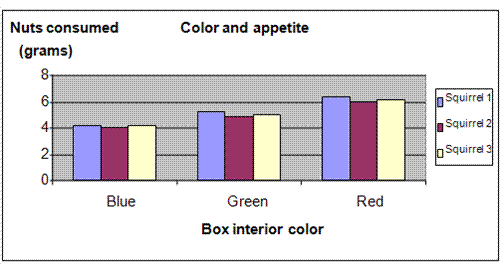| Complexity level: | 7 |
| Project cost ($): | 80 |
| Time required: | 2 days to prepare, 9 days for the science fair project experiment |
| Material availability: | May be found at a hardware store and pet store |
| Safety concerns: | Basic safety requirements. Handle animals with care to avoid being bitten. |
Hypothesis
The squirrels in the red box will eat the most nuts.
Overview
Color psychology
Colors have a strong effect on setting the mood and feeling of a person when he enters a room. Color is not only for the eyes . There are also psychological and physiological effects produced by colors on a person. Knowledge of this subject can help us choose the right color for our living rooms, bedrooms, dining, kitchen and even offices to enhance the quality of our lives.
Blue is the favorite color for both genders. It is a calming, soothing and relaxing color. Blue also makes us more spiritual and focused. It is a suitable color for study rooms and bedrooms. However, we are instinctively wired to resist food that is blue in color and it serves as an appetite suppressant. Blue is not advisable for the walls of kitchens, dining rooms and restaurants.
The effects of the color red are the opposite of blue. It is known to increase respiration and blood pressure. Red color also stimulates appetite and conversation. Shades of red like pink are known to calm anger and violent behavior. Orange is a cheerful color and also helps to improve the appetite. It is suitable for kitchens and dining rooms.
Other colors like green are soothing and are believed to help to improve digestion. Yellow color increases metabolism and makes people angry.
Scientific Terms
Materials
The materials required for this science fair project:
- 3 squirrels
- 3 wooden boxes
- 3 pieces of wire mesh to cover the top of the box
- Paint – of the following colors: blue, green and red
- Paint brush
- 1 bag of nuts
- 3 feeding bowls
- 1 digital weighing scale
Procedure
1. For this science fair project, the independent variable is the color of the interior of the box – blue, green or red. The dependent variable is the average amount of nuts eaten by the squirrel in 3 days. This is determined by using the digital scale to weigh the food supplied on the first day and once more on the third day. The constants (control variables) are the size of the box, the type of food supplied and the age of the squirrels.
2. The interior of the 3 boxes are painted blue, green and red in color and allowed to dry for 2 days. The wire mesh is cut and shaped to cover the top of the box so that the squirrels cannot escape from the box.
3. The 3 feeding bowls are filled with an equal number of nuts. The weight of the nuts placed in the bowl is measured using the digital weighing scale and recorded. The bowls are then placed inside the 3 boxes.
4. One squirrel is then placed inside each of the boxes and the top is immediately covered with the wire mesh. The squirrels are left alone for the next 3 days. After the third day, the bowl is removed from the box and the remaining nuts are weighed using the digital scale. The difference between the initial weight of the nuts and the new weight is calculated and divided by 3 to obtain the amount consumed daily. The result is recorded in the table given below.
5. The squirrel’s position in the colored boxes is rotated and the nuts are weighed and refilled in the feeding bowl. Procedure 5 is repeated once more after 3 days.
6. The squirrel’s positions will be rotated one final time so that the squirrels would have stayed in each box for 3 days. Procedure 5 is repeated once more after 3 days.

Results
The results show that the squirrels ate the most nuts when they were placed in the red box.
|
Box interior color |
Average daily consumption of nuts (grams) |
Average (grams) |
||
|
Squirrel 1 |
Squirrel 2 |
Squirrel 3 |
||
|
Blue |
4.19 |
3.97 |
4.23 |
4.13 |
|
Green |
5.27 |
4.83 |
5.01 |
5.04 |
|
Red |
6.32 |
5.95 |
6.17 |
6.15 |
The chart below represents the results of our science project experiment.

Conclusion
The hypothesis that the squirrels in the red box will eat the most nuts is proven to be correct. Squirrels are affected by color in the same manner as we are.
Choosing the right color when redecorating a home or business is very important to set the right mood and feeling for the occupants. The choice of colors can influence the mood, behavior and temperament of the occupants. Restaurants, kitchens and dining rooms should be painted red or orange instead of blue, which acts to suppress one's appetite!
Also consider
This science fair project may be repeated, this time, with other animals like dogs or cats.
Repeat the science project experiment, using different colored boxes like pink, yellow, orange, black, etc.
References
Choosing interior color - http://www.demesne.info/Improve-Your-Home/Choosing-Interior-Color.htm
Appetizing color for the dining room - http://www.decoratorsecrets.com/dining-room-color.html

